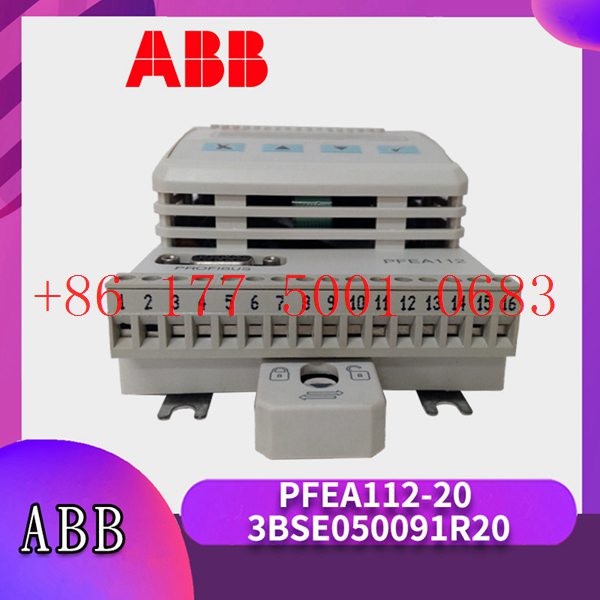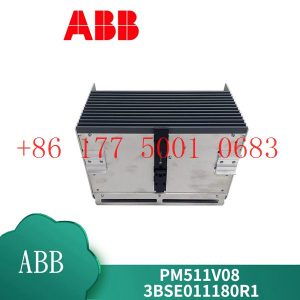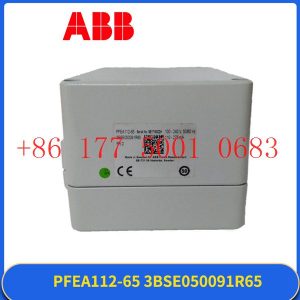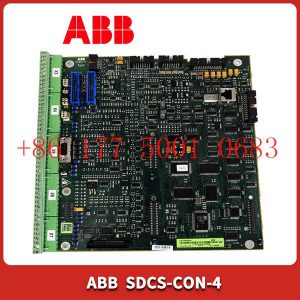Description
3BHE021083R0101 XVC770BE101 Использование параметров ABB
Implementation of communication between ABC industrial robot and PLC based on DeviceNet fieldbus technology
introduction
In modern production systems, industrial robots and PLCs need to communicate and collaborate to complete production tasks. That is, the
industrial robots output signals to the PLC, allowing the PLC to control related equipment to drive the robot”s front-end tools. This article
mainly analyzes the communication problems between ABB industrial robots and PLC based on DeviceNet fieldbus technology.
DeviceNet is a common network communication method in the field of automation. ABB industrial robots establish a network to communicate with
Siemens PLC based on the DeviceNet network.
1Configure DSQC652
There are mainly 5 types of standard I/0 boards commonly used in ABB industrial robots [2]. Except for the different addresses assigned to
them during setup, their configuration methods are basically the same. This article mainly analyzes the ABB standard I/0 board DS0C652, which
mainly builds communication modules based on the DeviceNet network. The DS0C652 board has a distributed I/O module with 16 digital input and 16
digital output interfaces. The board is installed in the ABB industrial robot control cabinet. First, define the specific operation steps of the DS0C652 board,
enter the teach pendant control panel, then enter the configuration menu (Figure 1), select the DeviceNetDevice menu, and add a template to enter Figure 2.
ABB standard I/0 board is hung on the DeviceNet
network, so the address of the module in the network must be set. The jumpers 6 to 12 of terminal x5 are used to determine the address of the module.
The available address range is 10 to 63. Modify the parameters in the template parameters to complete the DS0C652 board settings. Click the drop-down
menu to select the “Use value from template” row, select
“DS0C65224VDCI/0Device”, and then the parameters that need to be set include the address of the I/0 board in the bus.
Figure 1 Configuring DSQC652
2Configure signals and parameters
After completing the DS0C652 board setting, the I/0 signal setting will be performed. Setting the I/0 signal is the basis for establishing communication with
the PLC. The PLC communicates and transmits data with the ABB industrial robot through the I/0 signal and the DS0C652 board. As shown in Figure 3, in the
signal configuration interface, there are many default I/0 points after the system is established. Modification is not allowed. Click “Add” to add signals. When setting
input and output signals, their address range is 0~15. First, enter the signal menu in the configuration options to set the input and output types, and modify the corresponding parameters.
After completing the settings, the computer prompts that you need to restart the settings. If there are multiple signals that need to be defined and the waiting time
is long after restarting multiple times, you can click “Cancel” and wait for all signals to be defined before clicking the “Yes” button to restart. After the signal settings are
completed, click to select “Input and Output” in the ABB menu to check whether all signals have been set.
Figure 2 Configure DSQC652 parameters
Figure 3 Signal parameter settings
During the signal establishment process, attention should be paid to the DSoC652 port and PLC port addresses used, and the corresponding address table should be
established, as shown in Table 1. The robot interacts with the PLC through I/O signals. During the setting process, there must be no errors in the port and address number
of the PLC connected to the DSoC652. If the address is set incorrectly, the communication between the robot and the PLC will not work properly.
The entire robot teaching pendant setting process is shown in Figure 4.
PM825 3BSE010796R1 ABB S800 Processor
S20330-SRS KOLLMORGEN SERIES SERVO DRIVE
VMIVME-5565-110000 VMIC Reflective Memory Node Card
5SHX2645L0002 3HB012961R0001 ABB IGCT module
140ACO02000 Schneider ANALOG OUTPUT MODULE
216EA61b HESG324015R1 KHESG324258R3I HESG448230R1 ABB Card module
1753-L32BBBM-8A Allen-Bradley Industrial controller
1756-L73XT Allen-Bradley Processor Module
3636R TRICONEX Relay Output Module
3721 TRICONEX Analog Input Module
05701-A-0302 HONEYWELL Single Channel Control Card Catalytic
AI810 3BSE008516R1 ABB Analog Input
DSAO120A 3BSE018293R1 ABB Analog Output Board
CI840A 3BSE041882R1 ABB Profibus DP-V1 Communication Interface
DO820 3BSE008514R1 ABB Digital Output
DS200TCEAG1ACB GE Processor module
DS200TCEAG1BNE DS215TCEAG1BZZ01A GE Emergency Over Speed Board
DVSC-TT-14C-09 DOOSAN Driver module
DSBC176 3BSE019216R1 ABB Bus Extender Board
IC695PSA040 GE power supply
FC-QPP-0002 HONEYWELL Quad Processor
IC698CRE040-HN GE Processor module
IC698PSA100 GE power supply module
IC698CRE030-EE GE Pentium-M redundancy CPU
IS220PAICH2A 336A4940CSP11 GE analog input/output module
PFSK164 3BSE021180R1 ABB Circuit board card
PM864 3BSE018161R1 ABB Processor Unit
PPC380AE01 HIEE300885R0001 ABB Digital input card
SM811K01 32SE018173R1 ABB Safety CPU module
SSA-G1018-0652 Enterasys Network Switch
T9481 ICS TRIPLEX Analog output module
UBC717BE101 ABB Main board
ACU-01B 3HNA024871-00102 ABB Robot controller unit
1785-L40C Allen-Bradley processor module
5301-MBP-DFCM PROSOFT Modbus Plus to DF1 master/slave gateway
3500/22M 288055-01 Bently Nevada Transient Data Interface Module
DS200ADPBG1ABB GE
DS200CPCAG1ABB GE
DS200CTBAG1ADD GE
DS200DPCBG1AAA GE
DS200DSPCH1ADA GE
DS200IIBDG1A GE
DS200KLDBG1ABC GE
DS200LDCCH1ANA GE
A06B-6120-H075 GE power-supply module
DS200PCCAG1ABB GE
DS200RTBAG2AFB GE
DS200SDCCG1AEC GE
DS200SDCIG2AHB GE
DS200SLCCG1ACC GE
DS200TBQCG1AAA GE
DS200SLCCG1AEE GE









Reviews
There are no reviews yet.